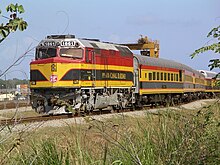Panama Canal Railway
| Panama Canal Railway | |||||||||||||||||||||||||||||||||||||||||||||
|---|---|---|---|---|---|---|---|---|---|---|---|---|---|---|---|---|---|---|---|---|---|---|---|---|---|---|---|---|---|---|---|---|---|---|---|---|---|---|---|---|---|---|---|---|---|
|
Route in purple, the Atlantic at the top left and the Pacific at the bottom right
| |||||||||||||||||||||||||||||||||||||||||||||
| Route length: | 76.6 km | ||||||||||||||||||||||||||||||||||||||||||||
| Gauge : | 1435 mm ( standard gauge ) | ||||||||||||||||||||||||||||||||||||||||||||
|
|||||||||||||||||||||||||||||||||||||||||||||
The Panama Canal Railway is a single track, non-electrified railway line in Panama operated by the Panama Canal Railway Company . The main handling is containers that are transported between the Atlantic side ( Colón ) and the Pacific side (Balboa near Panama City ). In addition, the only passenger train runs from Balboa to Colón in the morning and back in the evening (Mon-Fri); this is also used during the day for special trips in tourism. The railway line runs east of the Panama Canal and is not connected to other railway systems, so it is an island operation .
operator
The Panama Canal Railway Company is 50% owned by the holding company Kansas City Southern and Mi-Jack Products Inc. , a manufacturer of cranes for container handling. In 1998, the joint venture was granted a concession by the State of Panama to repair and operate the Panama Canal Railway for 25 years, including an option to extend it for a further 25 years.
vehicles
The company owns ten Electro-Motive Diesel F40PH diesel locomotives. The only passenger train consists of five historic open-plan cars, each with an open platform and a panorama car, and has an F40 locomotive at each end. Container traffic is carried out with double-deck container wagons. There are also rail vehicles for construction site traffic.
history
The first lift opened in 1855. The construction took place under very difficult circumstances, around 5,000 to 10,000 workers were killed, mainly due to illness.
The construction of the Panama Canal and the associated damming of Lake Gatun (1907 to 1913) made it necessary to change the route.
In 2001 the line was completely renewed and converted from the US broad gauge with 5 ft (1524 mm) to standard gauge . For this purpose, used standard-gauge diesel locomotives were purchased and the only tunnel at Miraflores was expanded so that double-decker container transport was possible. Concrete sleepers prevent termite damage on the sleepers.
Web links
- Official Homepage (English)
- Along the Canal - Railway in Panama from theSWR Railway Romantic series, episode 904
Individual evidence
- ^ Kansas City Southern, 2015 Annual Report. (PDF) Kansas City Southern , 2016, p. 9 , accessed February 14, 2020 .



